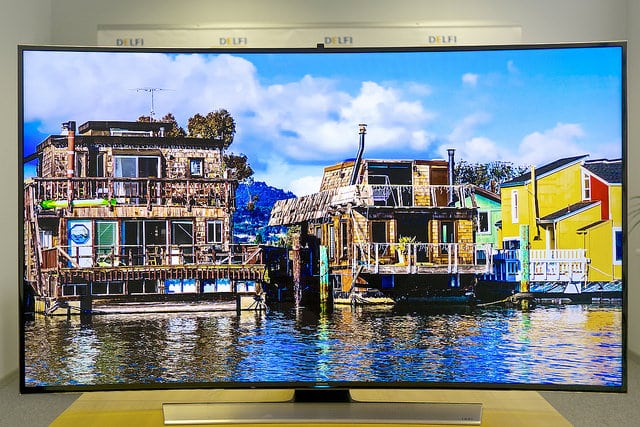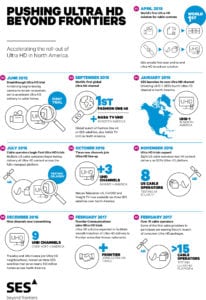Latest News

Samsung Curved UHD TV. Photo: Flickr.
Back in 2015, Steven Corda set a plan in motion. As vice president of business development for SES, it was his job to turn an Ultra-HD TV demo booth at the National Association of Broadcasters (NAB) show into a real, revenue-generating service connected to cable operators across North America. And he wanted to do it in half the time it took HD to go from concept to linear TV — or just two years. The only way that would happen, Corda said, was if SES focused “on the entire end-to-end system.” So the company approached the mass adoption of Ultra-HD in increments, knocking down barriers to entry throughout the business chain. In doing so, SES has accelerated the commercial viability of Ultra-HD TV right on Corda’s schedule.
Now, just a month shy of the two-year mark, SES boasts more than two dozen cable operators signed up for market trials, ranging from Aureon in Iowa to KPU Telecommunications in Alaska. SES’ Ultra-HD platform currently hosts nine linear channels with a 10th on the way. According to Corda, this is the largest bundle of Ultra HD programming in North America. In fact, adoption of Ultra-HD has ramped up so quickly that Corda believes we are just weeks away from the first commercial launch by IPTV or fiber-based providers. Cable operators will be soon to follow — “around June or July,” he expects.
According to Corda, one of SES’ biggest advantages was the drive by TV manufacturers to push Ultra-HD television sets. Companies such as Samsung, Vizio and LG are all retailing Ultra-HD TVs for less than $500 on the lower end, and some have even removed 1080p models from their lineups entirely. “The price points are incredible,” Corda said. “Why would you buy an HD TV when you can buy an Ultra-HD TV for essentially the same price?” Sales numbers are already encouraging, with at least one Ultra-HD TV in 1 in 8 North American homes by the end of 2016. Strategy Analytics expects that ratio to grow to 1 in 2 by 2020.
So with consumers already pushing toward the future, the next biggest challenge was getting cable operators on board. “[We wanted] to help operators, from a technology point of view, be able to easily ingest Ultra-HD into their system because it is a little different [from HD],” Corda said. “The biggest difference of course is the bandwidth; it’s a lot more bandwidth — at least twice as much.” SES landed on a nominal data rate of 18 megabits per second across all its channels, which Corda says reduces the cost to satellite access on the cable side. “In fact it’s a bit of a surprise for a lot of the cable operators,” Corda added. “They ask us what’s the data rate, we explain it, and they say, ‘Woah… that seems reasonable.’ That’s where HD started a few years ago and it kept getting better and better.”
SES also deployed a high-density satellite receiver to cable operators that allows them to receive up to 16 of SES’ Ultra-HD program channels. And to make the transition smoothly, SES is offering to fully configure and manage that receiver for the operators, which Corda notes is something new for a satellite operator to do. “We really looked throughout the value chain to try to understand what the barriers are for programmers, cable operators and the subscribers, and focused on each of them as we deployed this,” he said. The end result has been a quicker-than-expected rollout. “Our forecast was four channels by 2017 and we’ve exceeded that by quite a few,” Corda said.
In terms of the competition from non-linear, Over-the-Top (OTT) providers such as Netflix and Hulu, which already offer some Ultra-HD streams, Corda admits they’ve actually helped a bit by building awareness about Ultra-HD content and programming. But non-linear services have one major problem: congestion.
“You don’t know exactly what the broadband is like into people’s homes, or the broadband connection from the distributor to the internet. All those bottlenecks will likely create congestion and a service that may not even be true Ultra-HD,” Corda said. Conversely, as part a linear network, SES can “ensure that the content presented on the subscriber’s screen is exactly what the cameraman expected to get there. No congestion, no spinning dials, no buffering. None of that exists.” Thus, Ultra-HD TV delivered via cable operators can especially thrive in the niche of live sports and other major events.
With just 15 operators currently under the SES umbrella out of the near thousand total in North America, Corda thinks his team has only hit the tip of the iceberg. He expects the pace of adoption to ramp up even further as the technology matures and it becomes easier and cheaper to deploy large numbers of Ultra-HD compatible set top boxes to subscriber homes. “That’s really probably the last element that’s getting resolved in real time right now,” Corda said. “But I don’t see any reason why it wont accelerate quicker than what we’ve already seen over the last couple of years. I think we’re still in that double-digit growth rate for quite some time.”
Corda said that while other satellite operators arguably took a “wait and see” approach, SES saw a tremendous opportunity early on in Ultra-HD. “As a result, SES is leading the way in Ultra HD innovation together with our cable and other MVPD partners. We’re easily two years ahead of the competition with our Ultra HD platform. That’s light years in the television industry.”
Get the latest Via Satellite news!
Subscribe Now